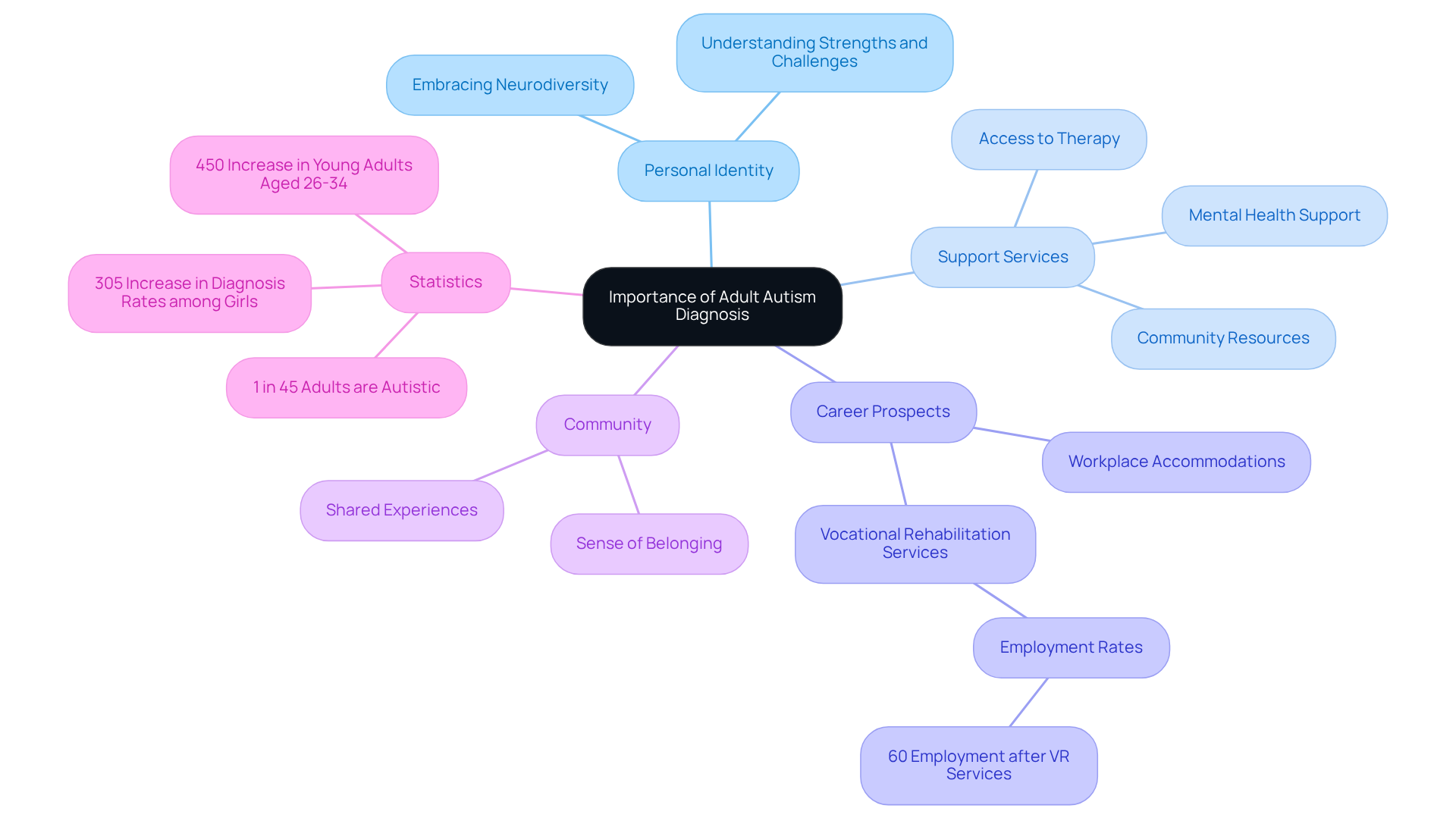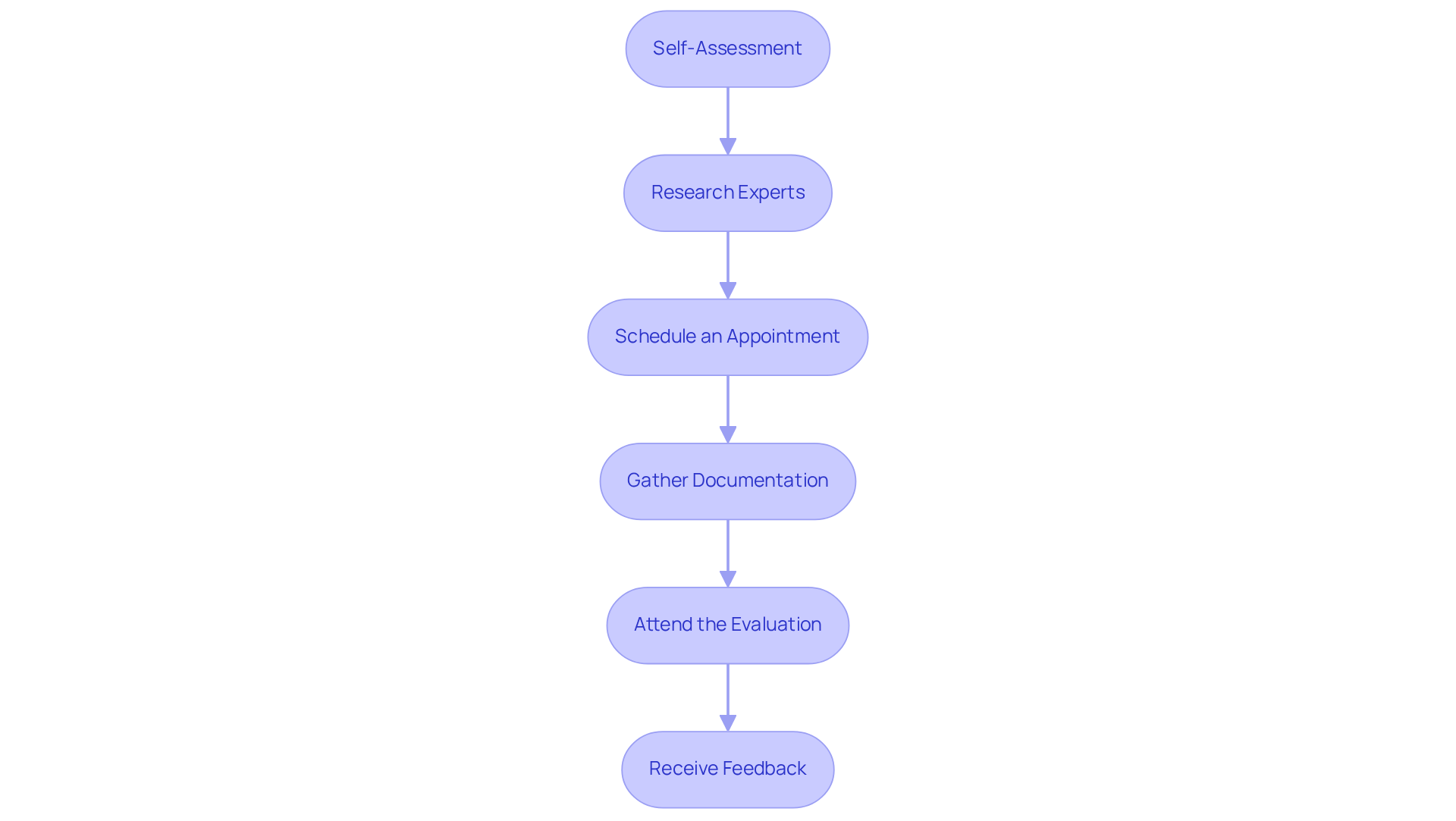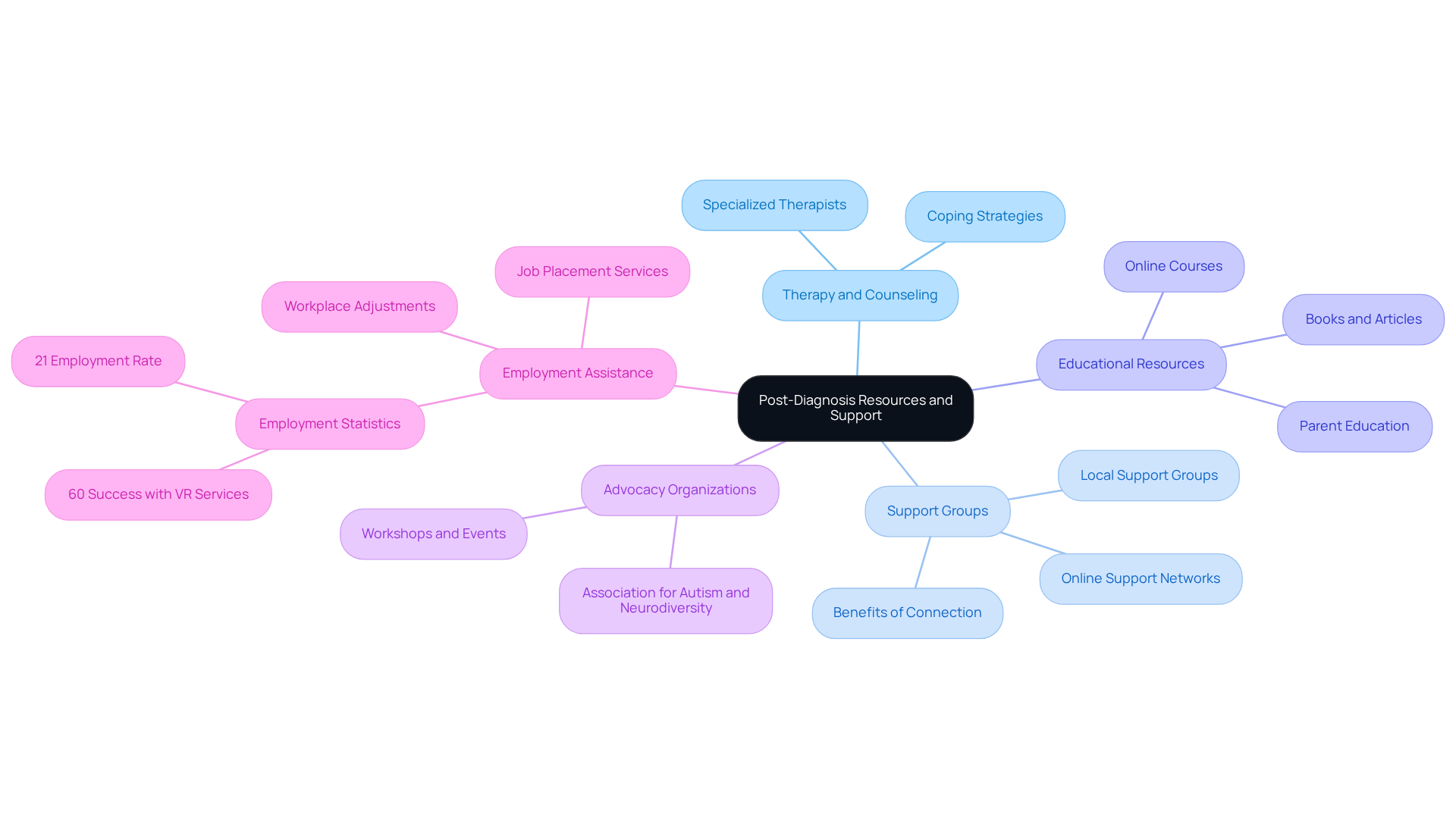Overview
Obtaining an adult autism diagnosis is a vital step that can illuminate one's identity and open doors to essential support services, ultimately enhancing quality of life. This article presents a thoughtful approach to diagnosis, highlighting the significance of self-assessment and expert consultations. By understanding these steps and utilizing post-diagnosis resources, individuals are empowered to navigate their unique challenges and fully embrace their neurodiversity. We invite you to explore this journey and discover the support available to you.
Introduction
Understanding one’s identity can be a profound journey, particularly for adults navigating the complexities of autism. An adult autism diagnosis not only illuminates personal strengths and challenges but also opens the door to essential resources and support systems that can significantly enhance one’s quality of life. However, the path to diagnosis is often filled with uncertainty and questions.
What steps must one take to secure this crucial recognition?
How can it reshape their future?
These inquiries are vital as they reflect the hopes and concerns of many on this journey.
Understand the Importance of an Adult Autism Diagnosis
A mature autism assessment can profoundly change a person's life by offering crucial insight into personal identity and teaching individuals how to get an adult autism diagnosis, which encourages a deeper comprehension of one's strengths and challenges. This formal recognition not only opens doors to various support services, such as therapy and community resources, but also significantly enhances overall quality of life by providing insights on how to get an adult autism diagnosis.
Many adults express that knowing how to get an adult autism diagnosis reduces confusion and self-doubt, allowing them to embrace their neurodiversity with pride. Furthermore, understanding how to get an adult autism diagnosis can improve access to workplace accommodations and mental health resources, which are vital for both personal and professional growth. For instance, nearly 60% of individuals with developmental disorders who obtain vocational rehabilitation services secure employment, highlighting how a diagnosis can lead to improved career prospects. This is particularly significant considering that only 21% of individuals with disabilities, including those on the spectrum, are employed.
Additionally, connecting with others who share similar experiences fosters a sense of belonging and community, reinforcing the notion that individuals on the spectrum are not alone in their journeys. As awareness of autism in adults increases, recognizing its impact on quality of life becomes increasingly essential, paving the way for a more inclusive society. It is estimated that 1 in 45 individuals in the United States are autistic, underscoring the importance of understanding and supporting this community. The rise in diagnosis rates among young individuals aged 26 to 34 further emphasizes the need for accessible support services tailored to their unique experiences.

Follow the Steps to Obtain a Diagnosis
- Self-Assessment: Start your journey by reflecting on your experiences and symptoms. You might find it helpful to use online self-evaluation tools that explain how to get an adult autism diagnosis by helping you identify characteristics linked to your condition. These tools offer valuable insights into your behaviors and thought patterns, serving as a meaningful first step in understanding your neurodivergence.
- Research Experts: Look for qualified specialists who focus on assessments for adults with developmental disorders. This could include psychologists, psychiatrists, or neuropsychologists. It's essential to ensure they have experience working with adults on the autism spectrum, particularly in guiding on how to get an adult autism diagnosis, as their expertise will be invaluable.
- Schedule an Appointment: Reach out to the professional you've chosen to arrange an evaluation. During this initial conversation, be prepared to discuss your concerns and motivations for seeking an evaluation related to how to get an adult autism diagnosis. This openness will help set the stage for a supportive assessment process.
- Gather Documentation: Collect any relevant documents that may assist in the assessment. This could include medical records, educational history, and notes from family or friends about your behaviors and challenges. It's also important to remember that the cost of evaluations for developmental disorders, such as how to get an adult autism diagnosis, can range from $3,800 to $5,800, so consider this in your planning.
- Attend the Evaluation: During the assessment, the clinician will likely conduct interviews, administer questionnaires, and observe your behavior. Approach this process with honesty and openness about your experiences to ensure an accurate evaluation. Be mindful that waiting lists for autism assessments can vary significantly, ranging from six months to two years, which highlights how to get an adult autism diagnosis promptly.
- Receive Feedback: After the assessment, the clinician will provide feedback regarding the evaluation. If a diagnosis is made, they will discuss the next steps and available resources tailored to your needs. As Dr. Marilyn J. Montiero emphasizes, the diagnostic process is about sharing the strengths-based story of the individual, empowering you to navigate your journey with greater clarity.

Explore Post-Diagnosis Resources and Support
After receiving an autism diagnosis, it's essential to explore available resources and support systems to foster personal growth and well-being.
-
Therapy and Counseling: Collaborating with therapists who specialize in spectrum disorders can be incredibly beneficial. These professionals are equipped to help navigate emotional challenges and develop effective coping strategies that are tailored to individual needs.
-
Support Groups: Engaging in local or online support groups for individuals on the spectrum provides a safe environment to share experiences and seek advice. Connecting with others who understand similar journeys can enhance one's sense of belonging. Recent studies highlight that many individuals find these networks invaluable, especially as awareness of developmental disorder characteristics among adults has led to more diagnoses, emphasizing the importance of these groups.
-
Educational Resources: Accessing a variety of books, articles, and online courses focused on autism can deepen understanding and offer practical strategies for managing daily challenges, ultimately fostering personal development. Additionally, parent education plays a crucial role in the success of ABA therapy, as informed parents can reinforce strategies learned in therapy.
-
Advocacy Organizations: Connecting with groups dedicated to supporting autistic individuals, such as the Association for Autism and Neurodiversity, can provide valuable resources. These organizations often host workshops and events designed to help individuals navigate their new identities and rights, empowering them to advocate for themselves effectively.
-
Employment Assistance: If you're seeking work or workplace adjustments, reaching out to organizations that focus on job placement for those on the autism spectrum can be a great step. They can help identify suitable job opportunities and advocate for necessary adjustments in the workplace. It's important to note that only 21% of individuals with disabilities, including autism, are employed, yet nearly 60% of those who receive vocational rehabilitation services find employment. This statistic underscores the effectiveness of these supports and the potential they hold for individuals on the spectrum.

Conclusion
Understanding the journey toward obtaining an adult autism diagnosis is essential for nurturing personal growth, enhancing quality of life, and embracing one's unique identity. A formal diagnosis not only sheds light on an individual's experiences but also opens doors to vital resources and support systems, empowering individuals to navigate their lives with greater confidence and clarity.
Throughout this article, we have highlighted the importance of:
- Self-assessment
- Researching qualified specialists
- Preparing for the evaluation process
Engaging in therapy, joining support groups, and accessing educational resources are crucial steps that can significantly enrich the lives of those diagnosed. Moreover, the potential for improved employment opportunities through vocational rehabilitation services underscores the tangible benefits that accompany receiving an autism diagnosis.
Ultimately, seeking an adult autism diagnosis is a powerful step toward self-discovery and empowerment. It is vital to recognize the significance of this journey, not only for personal fulfillment but also for fostering a more inclusive society. By advocating for oneself and connecting with available resources, individuals can unlock their potential and contribute meaningfully to their communities. Embracing neurodiversity is not just a personal journey; it is a collective movement toward understanding and acceptance.
Frequently Asked Questions
Why is an adult autism diagnosis important?
An adult autism diagnosis is important because it provides crucial insight into personal identity, helps individuals understand their strengths and challenges, and opens doors to support services such as therapy and community resources, ultimately enhancing overall quality of life.
How does obtaining an adult autism diagnosis affect self-perception?
Many adults report that knowing how to get an adult autism diagnosis reduces confusion and self-doubt, allowing them to embrace their neurodiversity with pride.
What benefits can come from an adult autism diagnosis in the workplace?
An adult autism diagnosis can improve access to workplace accommodations and mental health resources, which are vital for personal and professional growth. It can also lead to better career prospects, as nearly 60% of individuals with developmental disorders who obtain vocational rehabilitation services secure employment.
What is the employment rate for individuals with disabilities, including those on the autism spectrum?
Only 21% of individuals with disabilities, including those on the autism spectrum, are employed.
How does connecting with others benefit individuals on the autism spectrum?
Connecting with others who share similar experiences fosters a sense of belonging and community, reinforcing the notion that individuals on the spectrum are not alone in their journeys.
What is the prevalence of autism in the United States?
It is estimated that 1 in 45 individuals in the United States are autistic, highlighting the importance of understanding and supporting this community.
Why is there an increased focus on adult autism diagnoses for younger individuals?
The rise in diagnosis rates among young individuals aged 26 to 34 emphasizes the need for accessible support services tailored to their unique experiences.




